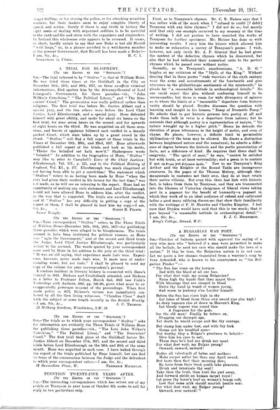TENNYSON TWENTY-FIVE YEARS AFTER. IT° THE Emma or TER "
&corm.")
Sia,—The interesting correspondence which has arisen out of my article on Tennyson in your issue of October 6th seems to call for reply in two particulars only. First, as to Tennyson's rhymes. Mr. C. R. Heine]; says that I was rather wide of the mark when I "refused to credit [7 debit] Tennyson with any false rhymes." I did not do so; but merely mid that only one example occurred to my memory at the time of writing. 1 did not profess to have searched the works of Tennyson for further specimens. Mr. Haines has done so with interesting results. 1 envy him the leisure which allowed hint to make so exhaustive a survey of Tennyson's poems. I wish, however, not only (with Mr. A. P. Graves) that he had given the context of the defective rhymes which he discovered, but also that he had indicated their numerical ratio to the perfect rhymes which he passed over without notice.
Secondly, as to Tennyson's anachronisms, "A. D. G. " boggles at my criticism of the "Idylls of the King." Without denying that in these poems "rude warriors of the sixth century vicar the arms and accoutrements of the fourteenth and give utterance to the philanthropic sentiments of the nineteenth," he pleads for "a reasonable latitude in archaeological details." No one could reject this plea without confessing himself to be unreasonable; but there is room for wide divergence of opinion as to where the limits of a "reasonable" departure from historic verity should be placed. Dryden discusses the question with learning and insight in his famous "Essay of Dramatic Poesy." He admits that to put historic persona into poetry at all and make them talk in verse is a departure from nature; but he contends that although poetry is a representation of nature, "'tie nature wrought up to a higher pitch." Hence he defends the elevation of prose utterances to the height of metre, and even of rhyme. He places, however, a definite limit to permissible idyllization—if the term may be allowed. He draws a distinction between heightened nature and the unnatural; he admits a differ- ence of degree between the historic and the poetic presentation of facts, not a difference of kind. He requires that there shall be congruity. "The spirit of man," he says, "cannot be satisfied but with truth, or at least verieimility; and a poem is to contain if not rut grime yet &disown, au 014." Now to me Tennyson's Xing Arthur and the Knights of the Round Table are incongruous creatures. In the pages of Sir Thomas Eatery, although they masquerade in costumes not their own, they do at least retain their native villainy. But even this, their last link with historic fact, is taken from them by Tennyson, and they are transmuted into the likeness of Victorian clergymen of liberal views taking part in a pageant for the benefit of humanity—a pageant in which they work off to an ideal audience of refined and cultivated ladies a good many edifying discourses that show their familiarity with the writings of F. D. Maurice and Charles Kingsley. I feel sure that Dryden would have said that this is too much; that it goes beyond "a reasonable latitude in archaeological detail." -


































 Previous page
Previous page